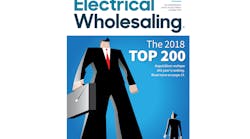Manufacturers, manufacturers' representatives and distributors all wrestle with the development and execution of winning business strategies in this uncertain economy. Most strategic planning initiatives fail because of several related reasons:
-
Strategy is conducted entirely with “inside-out thinking” and does not gather “outside-in feedback” from channel partners.
-
Analytical tools are not used to gather internal and external feedback.
-
No execution responsibility and accountability exists beyond the strategy planning session.
-
Strategic plans are not continually measured and linked to a scorecard system.
This 10-step strategy can help electrical distributors, reps and manufacturers gut out this economy:
Step 1 - Clearly and concisely define your strategic objectives. This should be your organization's purpose in measurable terms. A strategic objective should detail both what you stand for and where you expect to go. “What you stand for” is your company's purpose, its beliefs and values. “Where you expect to go” describes your company vision — its future. For example, what do you want your company to accomplish over the next three to five years?
Step 2 - When doing external market research, ensure anonymity of respondents by using a third party. When you conduct third-party confidential external market research to get an outside-in view of your company's strengths, weaknesses, opportunities and threats (SWOT), and analyze competitors, it's a moment of truth. Manufacturers kid themselves if they think they can gather candid and frank feedback from their channel partners. One manufacturer asked its reps to use a five-point rating scale to rate its top management, regional managers, customer service, timeliness of commissions payments, follow-up, inside sales support availability, marketing programs, communications with reps, product quality, new product development and introduction, sales literature and overall service quality.
These are all good assessment areas, but because they did not engage a third-party to gather this data and protect the identity of the respondents, they only received “feel good” responses. Reps were hesitant to bite the hand that fed them and offer candid responses. One rep complained that after the manufacturer convinced him to provide honest feedback that would be kept “completely confidential,” a regional manager berated him for providing negative feedback and threatened to pull the line. This rep says he will never again provide honest feedback directly to any manufacturer.
Step 3 - Perform an internal SWOT analysis. Conduct confidential internal SWOT analyses with every member of your strategy team to gain an inside-out view of strengths, weaknesses, opportunities and threats. This analysis is also best conducted by a third party who can gain anonymous frank and candid internal perceptions of the organization's internal strengths and weaknesses, external opportunities and threats.
Step 4 - Compare the outside-in and inside-out views of strengths, weaknesses, opportunities and threats. Once your management team does this analysis, formulate general strategies based on the alignment of strengths and opportunities. You will need to develop strategies that address your biggest weaknesses and capitalize on your greatest strengths. The table below can help you organize your thoughts when performing this strategic analysis.
Step 5 - Develop critical success factors. These are the strategic issues critical to your organization's future. If you are an electrical distributor, these issues might include strengthening your position in specific markets; providing superior order-fill rates; order-accuracy rates; on-time delivery rates; and improving people capabilities in product knowledge.
Step 6 - Craft a strategic goals statement. This clearly and concisely defines the direction of your organization to achieve your strategic objectives. Your strategic objectives must be “SMART” — specific, measurable, achievable (stretch), realistic and time-bound.
Step 7 — Utilize a balanced scorecard. Balanced scorecards surfaced in the early 1990s when Robert Kaplan and David Norton authored three Harvard Business Review articles on the subject. In these articles, they introduced the following four balanced scorecard perspectives: financial measures, customer measures, internal-business-process measures and employee learning and growth measures. Many leading companies today employ balanced scorecard measurements.
You should develop a three-year balanced scorecard to measure your organization's key financial measures, key customer and market measures, key internal-business-process measures and key employee learning and growth measures. To learn more about balanced scorecards, go to www.ewweb.com and type “enhancing profitability” into the search engine in the right-hand column. The article by that name explores balanced scorecards.
Step 8 - Identify your top three strategic initiatives. These strategies should capitalize on your company's top strengths, minimize its weaknesses, size up key opportunities and mitigate key threats in achieving your strategic goals.
Step 9 - Assemble strategy execution teams. Assemble three strategy execution teams to support achievement of your strategic goals and balanced scorecard. They should focus on developing and executing specific action plans that detail each strategic execution team's mission, goals, action tasks, owners of action tasks, and completion dates.
Step 10 - Conduct quarterly strategy execution team meetings. Use these meetings to review your progress and ensure achievement of balanced scorecard results.
These strategies have helped several of my clients. My firm recently worked with several electrical companies on their strategic planning. One electrical manufacturer had performed an internal SWOT analysis. But because they did not get external feedback, they were focused on the wrong key strategic initiatives. I conducted confidential market research with their manufacturers' representatives and distributor partners, facilitated a strategy session and got them focused on their top three strategic initiatives that can increase their market share. They are now well on the road to successful implementation.
My firm also recently held a strategy session with an electrical manufacturers' representative after conducting market research with their principals. As a result, this month they announced a strategic move to reduce the quantity of lines they represent from 13 to eight manufacturers. This decision will allow them to reposition their resources and assets to their premier manufacturers, dramatically increasing customer service, end-user activities, specification and demand creation.
In another example, an electrical distributor benefited from a customer satisfaction study my firm did that helped create a customer service guarantee program. It clearly defines their unique value in the marketplace. Despite the struggling economy, their customers are now rewarding them with increased business.
These 10 strategies can help get your company pointed in the right direction in this uncertain economy.
Thomas J. O'Connor owns Farmington Consulting Group, Farmington, Conn. He is a growth strategy consultant for electrical distributors, manufacturers, and manufacturers' representatives and a contributing writer to Electrical Wholesaling magazine. You can call him at (860) 676-7876 or contact him via e-mail at [email protected]. His company's website is www.fcgltd.com.








